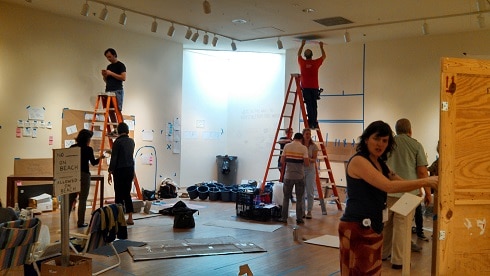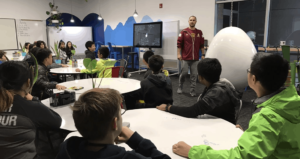Innovation Intermission

This month, I’ve been exploring alternate models of access to informal STEM (Science, Technology, Engineering, & Math) learning. This week, I’m taking a detour – an innovation intermission at a workshop with Nina Simon at the Santa Cruz Museum of Art and History.
Last week, four dozen innovators descended on Santa Cruz, California to shake up the way the informal education world thinks about participation. Our group included museum educators and exhibit designers, but also folks from mobile history museums, city symphonies, and public art departments – from as close as Santa Cruz itself and far away as New Zealand.
After a few inspirational talks (and a few explosions, and one indoor man-made raincloud), we split into groups to tackle exhibiting artifacts from the museum’s collection in innovative and engaging ways. After a friendly game of White Elephant to choose our artifacts, our groups got down to brainstorming ideas.

Illustration by Iris Gottlieb
The goal was to get away from the safe and familiar – does a painting have to be hung on a wall? Does a historical artifact need to have its history explained? How can we get people to interact with these objects? Some of us almost ignored the history of our artifacts, using them as jumping-off points to discuss world views, thinking about art, or everyday life. Others took conceptual approaches: what do vintage boardwalk tickets tell us about memory and ephemera?
The gallery became a battlefield of creativity. We had a little less than two days to test our exhibit ideas using cardboard, tape, and odds and ends from the fabrication shop – then make changes and build the real deal in time for the gallery’s public opening. We stayed up late, woke up early – some of us even slept on the floor of the museum – and fueled our mad dash to try out crazy ideas with coffee and burritos.
The results included new ways of exhibiting art and historical artifacts, and news ways to invite the public to view and interact with them. A turn-of-the-century optometry sign invited visitors to try on new perspectives when viewing objects. An abstract painting asked visitors to reimagine it in 3D using strips of colored fabric. A ball-pitching machine (invented in Santa Cruz) invited visitors to design their own inventions – which could then be 3D printed by a local company.

The final products of our fast-paced weekend are not the exhibits we created, but the ideas sparked, assumptions overturned, thoughts stirred up that we’ll all take home with us. It’s too easy to continue with the tried and true in informal education (museums and similar experiences) – informal environments, which often have much more flexibility than formal institutions like public schools – are important nurseries for innovation in education and engagement. Sometimes it takes a crazy few days at a particularly liberated museum to remember that.






0 Comments
Leave a Comment
Your email address will not be published. All fields are required.